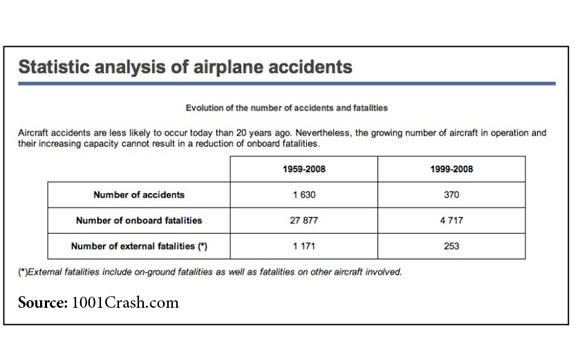How safe is airplane travel?
Commercial jet aviation is an exceptionally safe way to get from here to there. More than three million people around the world fly safely on commercial aircraft every day. In 1998, the world’s commercial jet airlines carried approximately 1.3 billion people on 18 million flights while suffering 10 fatal accidents.
How often do serious accidents happen?
They’re exceedingly rare. The risk of being involved in a commercial jet aircraft accident where there are multiple fatalities is approximately one in three million. To put this in perspective, you’d have to fly once very day for more than 8,200 years to accumulate three million flights.
Is flying getting safer or riskier?
Commercial aviation has always been the safest mode of long-distance travel. But it’s gotten even safer. Thirty years ago, fatal accidents on commercial jetliners occurred approximately once in every 140 million miles flown. Today, it’s 1.4 billion miles flown for every fatal accident — a 10-fold safety improvement.
What’s the risk of flying compared to driving?
In the US, it’s 22 times safer flying in a commercial jet than traveling by car, according to a 1993-95 study by the US National Safety Council comparing accident fatalities per million passenger miles traveled. The number of US highway deaths in a typical six-month period — about 21,000 — roughly equals all commercial jet fatalities worldwide since the dawn of jet aviation four decades ago. In fact, fewer people have died in commercial airplane accidents in America over the past 60 years than are killed in US auto accidents in a typical three-month period.
What causes commercial jet to crash?
There’s rarely a single cause. Usually it’s a combination of things. One reason accidents are so rare is that commercial aviation has so many redundant, backup systems to keep a problem from becoming serious. Typically this means that before a problem escalated into an accident, safety experts say, a series of increasingly unlikely events must occur, one after another. International teams are currently studying data in order to identify the most significant accident causes, and importantly, strategies for preventing them.
What’s the riskiest portion of a flight?
Takeoff and the climb to cruising altitude, and the descent and landing of an airplane are the two most risk prone periods of a flight. In overly simplistic terms, takeoff demands the most from an airplane in terms of engine thrust and structural integrity, while final approach and landing demand the most of the cockpit crew.
How do travelers know if airplanes are being properly maintained?
There are good reasons for air travelers to feel confident that the aircraft they are flying are well maintained. Airlines, aircraft manufacturers and government regulators jointly work out detailed, scheduled maintenance programs designed to avoid and catch problems before they become serious enough to jeopardize an aircraft’s ability to fly safely. In addition, flight crews and on-board computer systems monitor aircraft performance for any problems, and those problems that pose a safety threat are corrected before further flight.
What kind of maintenance steps do airlines take?
There are two basic types of maintenance: Scheduled maintenance, and unscheduled work focused on correcting faults that have occurred. For scheduled inspections, government regulators require increasingly detailed work, some of it tied to a plane’s age, its flying time, and the number of flights it has made. At each step in the process, mechanics probe deeper and deeper into an aircraft, taking apart more and more components for closer inspection.
Has deregulation made flying riskier?
No. In fact, flying has gotten considerably safer since the United States deregulated airfares and flight routes in 1978. In the 15 years leading up to deregulation, domestic airlines averaged one fatal accident for every 818,000 flights. In the 15 years following deregulation, US airlines averaged a fatal accident every 1.8 million flights. Since 1990, the accident rate has dropped even further to one per 2.2 million flights.
Are some jets safer than others?
No. Regardless of the manufacturer, all large passenger jets within a particular class must adhere to the same government safety standards. And all jets must pass exhaustive testing and analysis before they’re certified for commercial use. The airplane itself has been identified as the primary cause in only 10 percent of all jet accidents, according to worldwide accident data.
Are older airplanes less safe than newer ones?
An airplane’s age isn’t as relevant to safety as the way the aircraft is maintained and operated. It’s much like driving and old car: If all the key safety equipment — tries, brakes, steering, lights, shocks, wipers, etc. — are in top condition and you drive safely, wipers, etc — are in top condition and you drive safely, you risk will be minimal. The same is true of commercial aviation. Safety enhancements do not mean older jets are less safe since many of the key safety enhancements in incorporated in newer aircraft have been added to older planes in the fleet as well.
How safe are Boeing airplanes?
Somewhere in the world a Boeing jet is taking off or landing every two seconds — 24 hours a day, seven days a week. Boeing airplanes — 7 series and DC/MD models — have made more than 300 million safe, accident-free flights over the past four decades, including approximately 41,000 safe flights per day, every day, during 1998. In fact, Boeing jets make approximately 85 percent of the flights made by the world’s commercial jet transport fleet.
How safe is flying? Boeing answers...
How safe is flying? Boeing answers...











